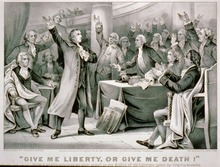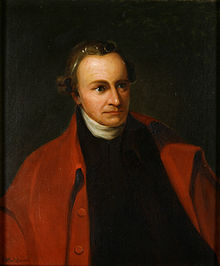Give me liberty or give me death!
[1] Henry is credited with having swung the balance in convincing the convention to pass a resolution delivering Virginian troops for the Revolutionary War.A scholarly debate persists among colonial historians as to what extent Wirt or others invented parts of the speech including its famous closing words.[5] On March 23, Henry defended his amendments and purportedly concluded with the following statement: If we were base enough to desire it, it is now too late to retire from the contest.[6]As he concluded, Henry plunged a bone paper knife towards his chest in imitation of the Roman patriot Cato the Younger."[10] Henry's speech ultimately swayed the convention,[11] and it was resolved that the colony be "put into a posture of defence: and that Patrick Henry, Richard Henry Lee, Robert Carter Nicholas, Benjamin Harrison, Lemuel Riddick, George Washington, Adam Stephen, Andrew Lewis, William Christian, Edmund Pendleton, Thomas Jefferson and Isaac Zane, Esquires, be a committee to prepare a plan for the embodying arming and disciplining such a number of men as may be sufficient for that purpose.[8] Upon learning of Dunmore's decision, Patrick Henry led his militia toward Williamsburg to force return of the gunpowder to the colony.[3] Furthermore, Wirt's reconstruction is devoid of Henry's rhetorical custom of invoking fear of Indian attacks in promoting independence from Britain.The 1320 Declaration of Arbroath made in the context of Scottish independence was a letter to Pope John XXII that contained the line: "It is in truth not for glory, nor riches, nor honours that we are fighting, but for freedom—for that alone, which no honest man gives up but with life itself".It is commonly cited as an inspiration for the Declaration of Independence by many, including Trent Lott in a speech before the United States Senate.[23] It contains the line, "It is not now time to talk of aught/But chains or conquest, liberty or death" (Act II, Scene 4).In the summer of 1787, the armed citizens' militia of the Dutch Republic paraded and drilled beneath banners extolling "Liberty or Death".[35] During the Russian Civil War, the flag used by Nestor Makhno's anarchist Revolutionary Insurrectionary Army of Ukraine had the dual slogans "Liberty or Death" and "The Land to the Peasants, the Factories to the Workers" embroidered in silver on its two sides.[36] In March 1941, the motto of the public demonstrations in the Kingdom of Yugoslavia against the signing of a treaty with Nazi Germany was "Better grave than slave" (Bolje grob nego rob).





Give Me Liberty (disambiguation)Patrick HenryCurrier and IvesLibrary of CongressWashington, D.C.oratorSecond Virginia ConventionSt. John's ChurchRichmond, VirginiaRevolutionary WarUnited States presidentsThomas JeffersonGeorge WashingtonWilliam WirtThomas SullySt. John's Episcopal ChurchContinental CongressHanover CountyBritish Empirepaper knifeCato the YoungerGunpowder IncidentVirginia in the American RevolutionEdmund RandolphGeorge MasonVirginia Declaration of RightsThomas MarshallJohn MarshallChief Justice of the United StatesEdward CarringtonRichard Henry LeeRobert Carter NicholasBenjamin HarrisonAdam StephenAndrew LewisWilliam ChristianEdmund PendletonIsaac ZaneLord Dunmoregovernor of VirginiaRoyal Navyremove all stocks of gunpowderWilliamsburg, VirginiaBattle of LexingtongovernorWilliam Wirt (Attorney General)St. George Tuckername-callingBernard MayoCato, a TragedyDeclaration of ArbroathScottish independencePope John XXIIDeclaration of IndependenceTrent LottUnited States SenateFounding FathersContinental ArmyValley ForgeCulpeper MinutemenHandeloratorioJudas MaccabeusHong Kong2019–2020 Hong Kong protestsliberty or deathDutch RepublicFrench RevolutionFranceSociety of United Irishmen1798 rebellionCastle Hill convict rebellionGreek War of IndependenceEleftheria i thanatosOttomanPedro I of BrazilPortugalUruguayOrientales, la Patria o la TumbaSerbian Chetnik OrganizationRussian Civil WarNestor MakhnoRevolutionary Insurrectionary Army of UkraineKingdom of YugoslaviaIndonesian National RevolutionPemudaThe Ballot or the BulletClevelandMalcolm Xre-education through laborChinese Communist PartyCOVID-19 protests in ChinaChongqingLiberty or Death (disambiguation)Flag of the Treinta y TresJoin, or DieLive Free or DieLiberté, égalité, fraternitéGive Me Liberty (1936 film)Give Me Convenience or Give Me DeathRowman & LittlefieldThe Colonial Williamsburg FoundationStanford University PressBate, Walter JacksonHarcourt Brace JovanovichBreitman, GeorgeGrove WeidenfeldNetEaseWilliam and Mary QuarterlyCrampton, WilliamGallery BooksBlackwellEikhenbaum, Vsevolod M.Black & Red BooksHändel, Georg FriedrichStanford UniversityHart, James D.Oxford University PressQuarterly Journal of SpeechThe Washington PostJohnson, SamuelThomas CadellKidd, Thomas S.Basic BooksKukla, JonSimon & Schuster